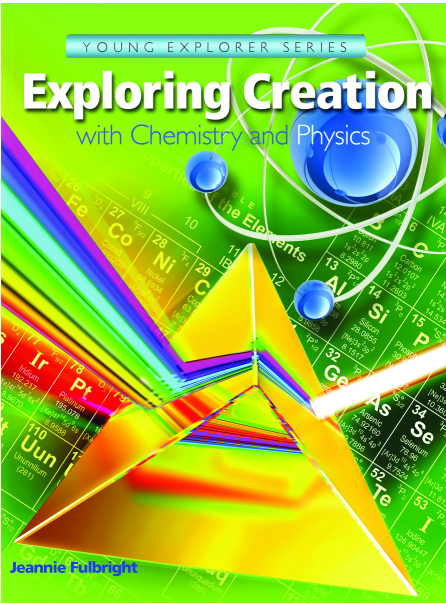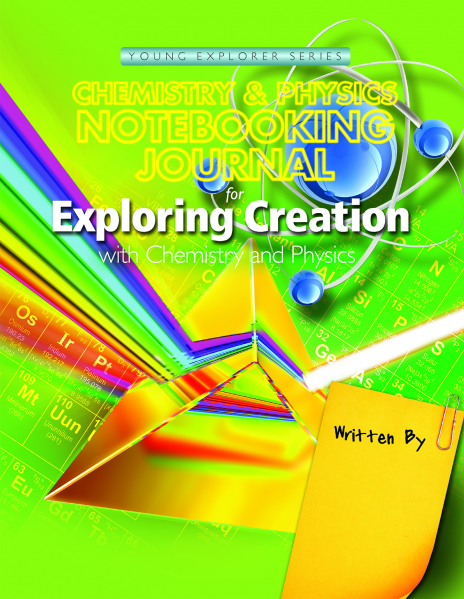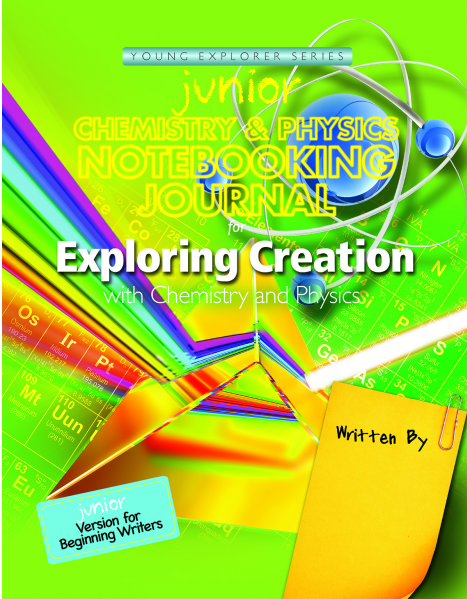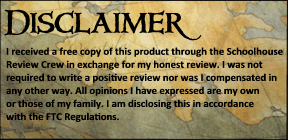Science is such an important subject to teach our kids. I was recently sent Exploring Creation with Chemistry and Physics from Apologia Educational Ministries to review and use with my own family. In addition to the text, I received the Exploring Creation with Chemistry and Physics Notebooking Journal for my oldest student and the Exploring Creation with Chemistry and Physics Junior Notebooking Journal for her younger brother.

Apologia Exploring Creation with Chemistry and Physics
The main text book is for students from Kindergarten through 6th grade. The text book sells for $39 and both notebooking journals have a price of $24 each. All of these materials can be used together in order to teach multiple students the same material. This is one part about Apologia that I really love. I have multiple kids that I’ll homeschool at the same time for many, many years, and this is one subject that I don’t have to worry about splitting up my time for. I love time savers!
How We Used It
For the purpose of the review, I wanted to sort of jump around a little bit to get a feel for more of the book than just the first few dozen pages. We did a few activities from many of the lessons to get a feel for it. We will certainly be going back and finishing up the information and experiments from the rest of the lesson! We do science 2-3 days per week, but I try to include at least reading from the textbook on a daily basis throughout the school week to keep the information fresh and to keep them thinking about it.
 The main textbook, Exploring Creation with Chemistry and Physics, is by Jeannie Fulbright. The text is divided between 14 lessons. You are probably thinking, “14 lessons? How is this supposed to last over an entire semester or school year? We do science several times a week!” Trust me, you will not have time to really go through all 14 lessons in a couple of weeks.
The main textbook, Exploring Creation with Chemistry and Physics, is by Jeannie Fulbright. The text is divided between 14 lessons. You are probably thinking, “14 lessons? How is this supposed to last over an entire semester or school year? We do science several times a week!” Trust me, you will not have time to really go through all 14 lessons in a couple of weeks.
Each lesson is approximately 16-18 pages of text with many subjects that you will naturally want to break up into several days. There are many “Try This!” activities within the text for this lesson, as well as a game. This isn’t even including all of the additional work and exploration you can do in the Notebooking Journals! They are optional, but are well worth the cost to continue to elaborate and expand upon what has been learned.
Think of each lesson as a chapter. For example, Lesson 6 talks about “Mechanics in Motion”. The sections are:
- Mechanical Mechanics
- Always in Motion
- Newton’s First Law of Motion (which also has subsections: Inertia in Motion, Roller Coaster)
- Newton’s Second Law of Motion
- Newton’s Third Law of Motion (with subsections: Newton’s Third Law in Space and Sir Isaac Newton)
- Final Matters
- What Do You Remember?
- Notebooking Activities
- Game: Ringers
In addition to those, there are 5 Try This! prompts in this lesson. Each activity is a short experiment that requires very easy to find materials to execute this correctly. It further illustrates what the kids have been reading about.
My favorite from this lesson was the one where we got to make our own model of a rocket using a bottle, some clay,and a few straws. This helps kids to see that science doesn’t have to be complicated and you don’t have to be an adult to use it and to make scientific observations.
 The Exploring Creation with Chemistry and Physics Notebooking Journal is for students with fairly good writing skills. There are writing prompts, notebooking activities, pages with copywork, puzzles such as crosswords, more experiment ideas, book suggestions, quiz pages (entitled “What Do You Remember?” so it doesn’t sound so scary!), activity ideas, and website suggestions.
The Exploring Creation with Chemistry and Physics Notebooking Journal is for students with fairly good writing skills. There are writing prompts, notebooking activities, pages with copywork, puzzles such as crosswords, more experiment ideas, book suggestions, quiz pages (entitled “What Do You Remember?” so it doesn’t sound so scary!), activity ideas, and website suggestions.
I found this journal to be perfect for my 3rd grade daughter, and would imagine that it would be excellent for any student that is fairly good at writing a paragraph or two. Third through sixth graders would probably be best suited for this journal if that is the case. Since there are so many open ended prompts, it could also easily be used with older students through at least junior high. They may want to skip the copywork, but everything else would apply.
If you’re imagining a notebooking journal that is going to require you to purchase separate supplies or a stack of manilla envelopes or some other things to support it, no worries! As long as your child has something to write with, all of the activities can be completed. To really get the most out of it, you’ll also need a pair of scissors and some glue. You might want something to color with like colored pencils as well, but really it is optional.
The simplicity of this notebook is wonderful! It is simple, yet it gives a snapshot of how much your child is retaining and learning from the text book.
 For younger students, there is the Exploring Creation with Chemistry and Physics Junior Notebooking Journal. This is for beginning writers and those that may need a little more help to do the suggested activities.
For younger students, there is the Exploring Creation with Chemistry and Physics Junior Notebooking Journal. This is for beginning writers and those that may need a little more help to do the suggested activities.
There are a few significant differences between the two versions of the notebooking journals that make this one the better choice for students in Kindergarten through 2nd or 3rd grade. First, the writing portions have handwriting worksheet style lines to help them with their writing prompts and copywork. Also, they have coloring pages throughout each lesson. There are more cut and paste activities in this versus the regular notebooking journal.
There are many likenesses between the versions as well. The activity, book, and website suggestions are the same for both notebooking journals. The activities are similar and the content practiced is the same for each journal. The suggested schedules presented use the same text and the similar notebooking pages so that each student will be doing the same types of activities on the same days, even if they are at different grade levels using different notebooking journals.
Things I Love:
- The textbook and both notebooking journals tell you how to use the books. You are not left trying to scramble to schedule or prepare. It is laid out and suggested for you.
- While they do have a suggested 28 week schedule, it could easily be accelerated or stretched out depending on your family’s needs.
- The text can be used with or without the notebooking journals. (I suggest with because it’ll truly enrich your experience!)
- This study is very hands on. Kids that learn best by doing will thrive.
- There is a master supply list. If you’re like me and want to be prepared so it’s as simple as just bringing out that day’s materials and getting to work, you’ll love this! Just purchase a supply kit or go pick up the materials as needed. (The list is divided by lesson.)
- Apologia Exploring Creation can be used with students of various ages at the same time. While it is a K-6 curriculum, preschool and pre-k younger siblings could jump in, and junior high or high school students could as well. The experiments are fun and could easily entertain and teach all levels. (I won’t lie – I learned a lot and I’m the mom!)
- The notebooking journal activities are excellent for on the go. I had my kids do many of the activities when we were in waiting rooms, on the road, or in line somewhere. That’s a great use of time!
- You can choose to participate in as many or as few experiments as time and interest allows for your family. Between the “Try This!” section in the books, the games and experiments for each chapter, and the suggested activities in the notebooking journals, there is no shortage of great ways to bring science to real life for your kids. However, if you just can’t do them all, do not be discouraged! Do what you can and be sure to bookmark the rest for a rainy day. That is a great way to bring the things they have been learning full circle at a later time.
Be Aware:
- If you hate doing experiments and trying things out with your kids, this curriculum will not appeal to you. It is very hands-on focused because the topics are much more interesting to experience rather than just read about!
- It may be neccesary for you to read to your students. My daughter is in 3rd grade and an excellent reader, but many of the terms used in this study were unfamiliar to her. As she read, she was sort of glossing over and not understanding the meaning. I found that when I read to the kids, they were able to understand the meanings a bit better right off the bat and I was able to easily add in extra information to help them understand what I just said.
If you have been searching for a solid homeschool science curriculum, I do encourage you to check out Apologia’s offerings. There are so many great choices for various age levels and content areas. If you’re interested in reading what other families thought about Apologia Exploring Creation, just click on the banner below.



[…] £ GBP […]